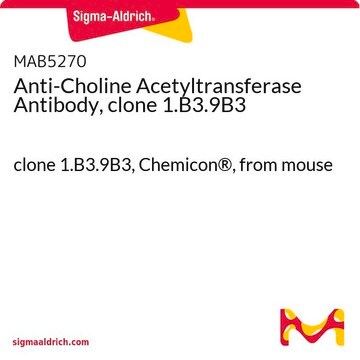MAB5258-I
Anti-Synaptophysin Antibody, clone SY38
clone SY38, from mouse
Synonyme(s) :
Synaptophysin, Major synaptic vesicle protein p38
About This Item
Produits recommandés
Source biologique
mouse
Niveau de qualité
Forme d'anticorps
purified immunoglobulin
Type de produit anticorps
primary antibodies
Clone
SY38, monoclonal
Espèces réactives
bovine, mouse, rat, human
Technique(s)
immunocytochemistry: suitable
immunofluorescence: suitable
immunohistochemistry: suitable (paraffin)
western blot: suitable
Isotype
IgG1κ
Numéro d'accès NCBI
Numéro d'accès UniProt
Conditions d'expédition
ambient
Modification post-traductionnelle de la cible
unmodified
Informations sur le gène
human ... SYP(6855)
Description générale
Spécificité
Immunogène
Application
Western Blotting Analysis: A 1:1,000 dilution from a representative lot detected Synaptophysin in 10 µg of rat hippocampus and human whole brain tissue lysates.
Immunocytochemistry Analysis: Representative lots immunostained presynaptic vesicles of 4% formaldehyde-fxied, 0.2% Triton X-100-permeabilzied primary mouse hippocampal neurons by fluorescent immunocytochemistry (Hu, X., et al. (2008). J. Neurosci. 28(49):13094-13105; Tarr, P.T., and Edwards, P.A. (2008). J. Lipid Res. 49(1):169-182).
Immunofluorescence Analysis: A representative lot immunostained presynaptic membrane of neurons by fluorescent immunohistochemistry staining of 4% paraformaldehyde-fixed, 0.3% Triton X-100-permeabilized, OCT-embedded rat spinal cord cryosections (Stück, E.D., et al. (2012). Neural Plast. 2012:261345).
Immunofluorescence Analysis: A representative lot immunostained synaptophysin around a large neuron in the ventral horn of the lumbar (L3/L4) segment by fluorescent immunohistochemistry staining of 2% paraformaldehyde/0.2% parabenzoquinone-fixed free-floating rat spinal cord sections (Macias, M., et al. (2009). BMC Neurosci. 10:144).
Immunofluorescence Analysis: A representative lot immunostained synaptophysin in bovine (pancreas) and human (pancreas, pheochromocytoma, and islet-cell carcinoma) frozen tissue sections (Wiedenmann, B., et al. (1986). Proc. Natl. Acad. Sci. U.S.A. 83(10):3500-3504).
Western Blotting Analysis: A representative lot detected an upregulated synaptophysin expression in human iPSCs with a 4-bp deletion in DISC1 gene (Wen, Z., et al. (2014). Nature. 515(7527):414-418).
Western Blotting Analysis: A representative lot detected synaptophysin distribution among PC12 rat pheochromocytoma cell membrane fractions (Salazar, G., et al. (2005). Mol. Biol. Cell. 16(8):3692-3704).
Western Blotting Analysis: A representative lot detected only synaptophysin recombinant contructs that contained the flexible segment -SGGGG- in the center of the c-terminal pentapeptide repeats (Knaus, P., and Betz, H. (1990). FEBS Lett. 261(2):358-360).
Neuroscience
Qualité
Western Blotting Analysis: A 1:1,000 dilution of this antibody detected Synaptophysin in 10 µg of mouse hypothalamus tissue lysate.
Description de la cible
Forme physique
Stockage et stabilité
Autres remarques
Clause de non-responsabilité
Not finding the right product?
Try our Outil de sélection de produits.
En option
Code de la classe de stockage
12 - Non Combustible Liquids
Classe de danger pour l'eau (WGK)
WGK 1
Certificats d'analyse (COA)
Recherchez un Certificats d'analyse (COA) en saisissant le numéro de lot du produit. Les numéros de lot figurent sur l'étiquette du produit après les mots "Lot" ou "Batch".
Déjà en possession de ce produit ?
Retrouvez la documentation relative aux produits que vous avez récemment achetés dans la Bibliothèque de documents.
Notre équipe de scientifiques dispose d'une expérience dans tous les secteurs de la recherche, notamment en sciences de la vie, science des matériaux, synthèse chimique, chromatographie, analyse et dans de nombreux autres domaines..
Contacter notre Service technique








